(完整word版)Unit3教学设计
- 格式:doc
- 大小:200.51 KB
- 文档页数:10
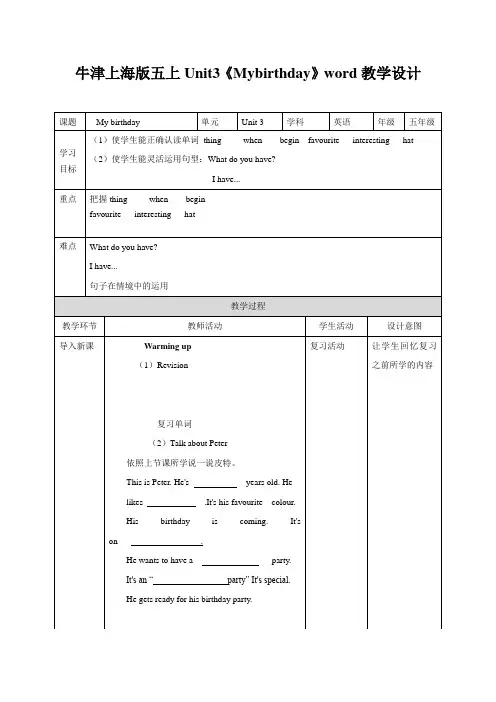

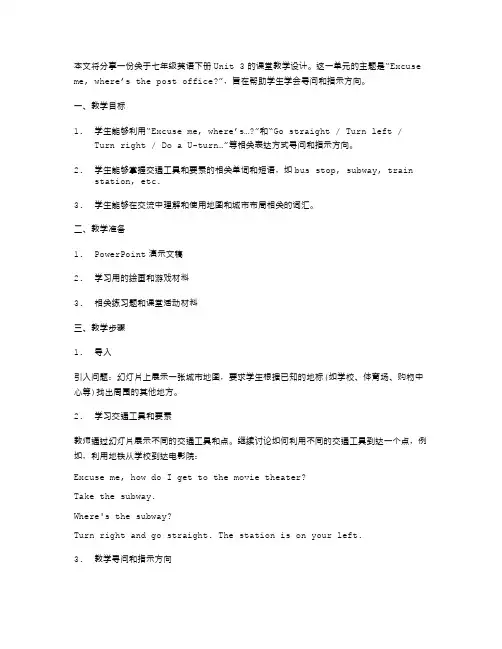
本文将分享一份关于七年级英语下册Unit 3的课堂教学设计。
这一单元的主题是“Excuse me, where’s the post office?”,旨在帮助学生学会寻问和指示方向。
一、教学目标1.学生能够利用“Excuse me, where’s…?”和“Go straight / Turn left /Turn right / Do a U-turn…”等相关表达方式寻问和指示方向。
2.学生能够掌握交通工具和要素的相关单词和短语,如bus stop, subway, trainstation, etc.3.学生能够在交流中理解和使用地图和城市布局相关的词汇。
二、教学准备1.PowerPoint演示文稿2.学习用的绘画和游戏材料3.相关练习题和课堂活动材料三、教学步骤1.导入引入问题:幻灯片上展示一张城市地图,要求学生根据已知的地标(如学校、体育场、购物中心等)找出周围的其他地方。
2.学习交通工具和要素教师通过幻灯片展示不同的交通工具和点。
继续讨论如何利用不同的交通工具到达一个点,例如,利用地铁从学校到达电影院:Excuse me, how do I get to the movie theater?Take the subway.Where's the subway?Turn right and go straight. The station is on your left.3.教学寻问和指示方向教师在幻灯片上展示不同地理位置的照片和地图,提示学生开始学习如何问路和指路。
教师向学生展示如何使用“Excuse me, where’s…?”句型,以及“Go straight / Turn left / Turn right / Do a U-turn…”等表达方式来指示方向。
教师可以与学生分组进行角色扮演,以加强他们的语言进程和提高他们的口语表达能力。
4.练习方向、地图和城市布局相关的词汇通过游戏、图片和绘画等多种形式收集和展示不同的地图和城市布局相关的单词和短语,例如:Bus stop / Subway / Train stationNorth / South / East / WestOn the left / On the right / Across the street / Next to5.面向现实场景的实践通过现实场景的练习加强学生的学习效果。
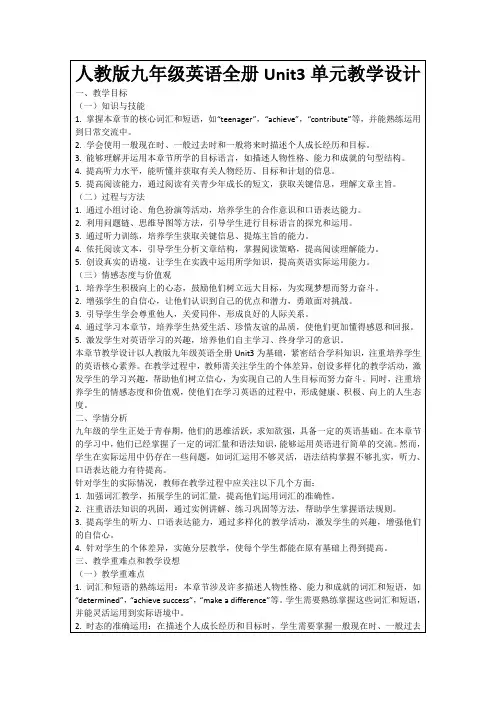
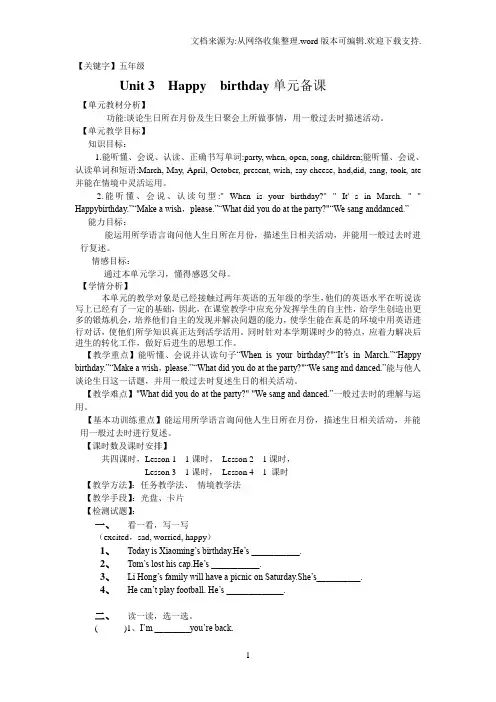
【关键字】五年级Unit 3 Happy birthday单元备课【单元教材分析】功能:谈论生日所在月份及生日聚会上所做事情,用一般过去时描述活动。
【单元教学目标】知识目标:1.能听懂、会说、认读、正确书写单词:party, when, open, song, children;能听懂、会说、认读单词和短语:March, May, April, October, present, wish, say cheese, had,did, sang, took, ate 并能在情境中灵活运用。
2.能听懂、会说、认读句型:" When is your birthday?" " It' s in March. " " Happybirthday.”“Make a wish,please.”“What did you do at the party?"“We sang anddanced.”能力目标:能运用所学语言询问他人生日所在月份,描述生日相关活动,并能用一般过去时进行复述。
情感目标:通过本单元学习,懂得感恩父母。
【学情分析】本单元的教学对象是已经接触过两年英语的五年级的学生,他们的英语水平在听说读写上已经有了一定的基础,因此,在课堂教学中应充分发挥学生的自主性,给学生创造出更多的锻炼机会,培养他们自主的发现并解决问题的能力,使学生能在真是的环境中用英语进行对话,使他们所学知识真正达到活学活用。
同时针对本学期课时少的特点,应着力解决后进生的转化工作,做好后进生的思想工作。
【教学重点】能听懂、会说并认读句子“When is your birthday?"“It’s in March.”“Happy birthday.”“Make a wish,please.”“What did you do at the party?"“We sang and danced.”能与他人谈论生日这一话题,并用一般过去时复述生日的相关活动。
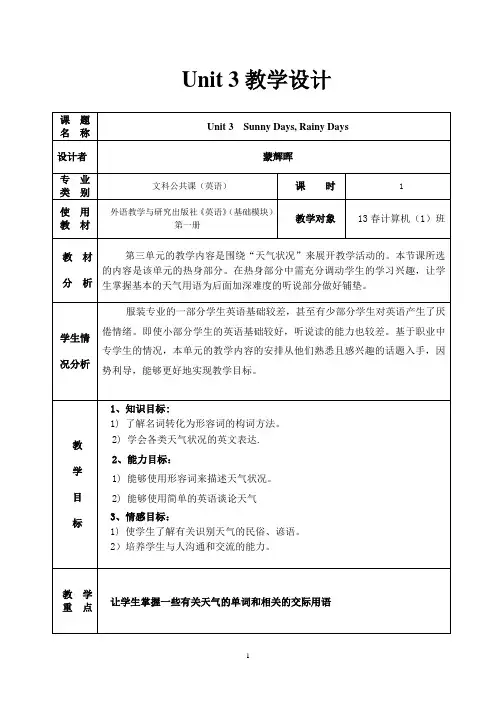
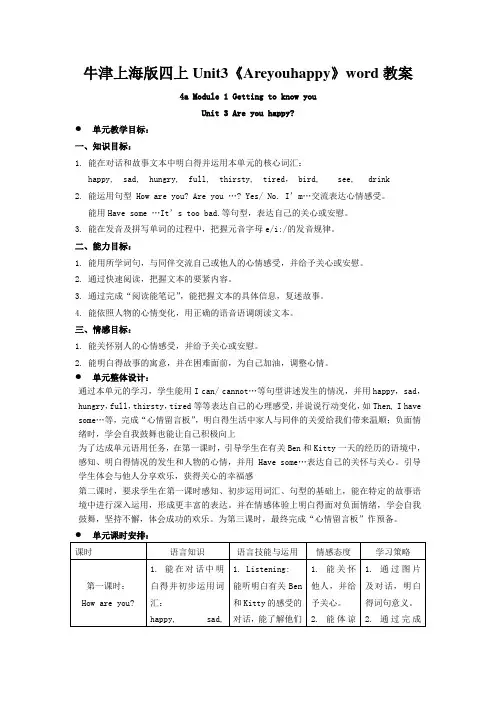
牛津上海版四上Unit3《Areyouhappy》word教案4a Module 1 Getting to know youUnit 3 Are you happy?●单元教学目标:一、知识目标:1. 能在对话和故事文本中明白得并运用本单元的核心词汇:happy, sad, hungry, full, thirsty, tired, bird, see, drink2. 能运用句型 How are you? Are you …? Yes/ No. I’m…交流表达心情感受。
能用Have some …It’s too bad.等句型,表达自己的关心或安慰。
3. 能在发音及拼写单词的过程中,把握元音字母e/i:/的发音规律。
二、能力目标:1. 能用所学词句,与同伴交流自己或他人的心情感受,并给予关心或安慰。
2. 通过快速阅读,把握文本的要紧内容。
3. 通过完成“阅读能笔记”,能把握文本的具体信息,复述故事。
4. 能依照人物的心情变化,用正确的语音语调朗读文本。
三、情感目标:1. 能关怀别人的心情感受,并给予关心或安慰。
2. 能明白得故事的寓意,并在困难面前,为自己加油,调整心情。
●单元整体设计:通过本单元的学习,学生能用I can/ cannot…等句型讲述发生的情况,并用happy,sad,hungry,full,thirsty,tired等等表达自己的心理感受,并说说行动变化,如Then, I have some…等,完成“心情留言板”,明白得生活中家人与同伴的关爱给我们带来温顺;负面情绪时,学会自我鼓舞也能让自己积极向上为了达成单元语用任务,在第一课时,引导学生在有关Ben和Kitty一天的经历的语境中,感知、明白得情况的发生和人物的心情,并用Have some…表达自己的关怀与关心。
引导学生体会与他人分享欢乐,获得关心的幸福感第二课时,要求学生在第一课时感知、初步运用词汇、句型的基础上,能在特定的故事语境中进行深入运用,形成更丰富的表达。
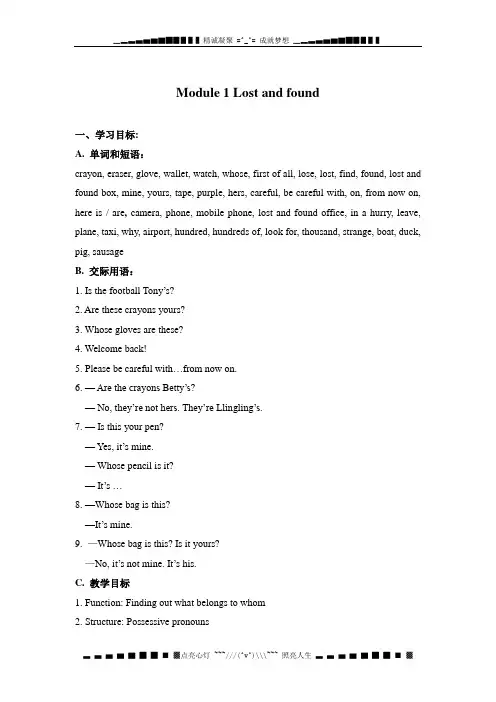
Module 1 Lost and found一、学习目标:A. 单词和短语:crayon, eraser, glove, wallet, watch, whose, first of all, lose, lost, find, found, lost and found box, mine, yours, tape, purple, hers, careful, be careful with, on, from now on, here is / are, camera, phone, mobile phone, lost and found office, in a hurry, leave, plane, taxi, why, airport, hundred, hundreds of, look for, thousand, strange, boat, duck, pig, sausageB. 交际用语:1. Is the football Tony’s?2. Are these crayons yours?3. Whose gloves are these?4. Welcome back!5. Please be careful with…from now on.6. —Are the crayons Betty’s?—No, they’re not hers. They’re Llingling’s.7. — Is this your pen?— Yes, it’s mine.— Whose pencil is it?— It’s …8. —Whose bag is this?—It’s mine.9. —Whose bag is this? Is it yours?—No, it’s not mine. It’s his.C. 教学目标1. Function: Finding out what belongs to whom2. Structure: Possessive pronouns3. Skills: 1) Listening and understanding familiar topics (school life)2) Talking about familiar topics (school life)3) Reading and understanding simple passages, grasping the general ideas.4) Using notes to convey messages4. Around the world: The Internet lost and found5. Task: Acting out a sketch in the lost and found office二、重点及难点:1、名词所有格;2、名词性物主代词的用法三、教学设计:Unit 3 Language in useⅠTeaching modelRevision and applicationⅡTeaching methodFormal and interactive practiceⅢTeaching aims1. Function: Finding out what belongs to whom2. Structure: Possessive pronouns3. Around the world: The Internet lost and found4. Task: Acting out a sketch in the lost and found officeⅣTeaching ObjectivesKey structures: Are these crayons yours?Whose bag is this?It’s mine.ⅤTeaching aidsTape recorder, OHP, handoutsⅥTeaching StepsStep 1 RevisionShow some pictures to review the text of Unit 1 and Unit 2.Step 2 Language practice1. Read through the example sentences in the box with the whole class.2. Ask the students to repeat the sentences in the box. Step 3 Work in pairs1. Ask the students to look at the pictures in Activity 1.2. Ask the students to the words in the box in Activity 1.3. Read through the sentences. — Whose bag is this? Is it yours? — No, it ’s not mine. It ’s his.4. Ask and answer questions in pairs. Step 4 Grammar. 代词表格用法1)人称代词的主格在句子中作主语,2)人称代词的宾格在句子中作宾语或在介词后、be动词后宾语,3)名词性物主代词=形容词性物主代词+名词,例:My bag is yellow, her bag is red, his bag is blue and your bag is pink. 可写成My bag is yellow, hers is red, his is blue and yours is pink.Step 5 Match.1. Ask the students to read the words in the box in Activity2.AB.2. Match the words from Box A with the words from Box B in Activity 2.3. Ask the students to check with a partner.4. Call back the answers from the whole class, check the answers . Keys:her → hers his → his your → yoursour → ours my → mine its →itsStep 6 Complete the sentences.1. Ask the students to read the words in the box in Activity 3.2. Read through the sentences.1) —Is this ______ sweater, Daming?—Yes, it is.2) —Are these gloves ______, Betty?—Yes, they are.3) —______ watch is this?—It’s Tony’s.4) —This wallet isn’t ______. Is it yours?—Yes, it is. Thank you.5) —Tony is looking for his crayons.—Are these ________?6) —Is this bag Betty’s?—No, it’s not _________. It’s Lingling’s.7) —Is this the girl’s football?—No, it’s not ________ football.8) I can’t find ______ camera. Where is it?9) —What’s the name of the dog?—________ name is Blackie.3. Complete the sentences with the correct form of the words from the box.4. Ask the students to check with a partner.5. Check the answers:Keys: 1. your 2. yours 3. Whose 4. mine 5. his 6. hers 7. her 8. my 9. Its Step 7 Do exercises( )1. —The pet cat in your hand is very nice . Is it _____?—Yes, but I’ll give it to my friend Lucy as ______ birthday present.A. you; herB. your; herC. yours; herD. you; hers( )2. —Is this _____ notebook?—No, it isn’t _____.A. theirs; theirB. hers; hisC. your; mineD. your; my( )3. —Excuse me , are these _____ new shoes ?—No, they aren’t. _____ are black over there.A. your, MineB. my; YourC. her; HerD. mine; Yours ( )4. —Hi, Jim. Is this your bike or Mary’s?—It’s mine, not _____.A. herB. himC. hisD. hers( )5. —Is this your key, Jenny?—No, ______ is in my handbag.A. HisB. HersC. MineD. Yours( )6. We are sure that our football players will do________ best.A. theirB. theyC. themD. themselves( )7. Please send ________ best wishes to Mary.A. IB. meC. myD. mineKeys:1-5: CCADC 6-7: ACStep 8 Around the world: Chinese food.1. Ask the students to look at the picture and discuss what they can see.2. Read through the information with the whole class.3. 阅读课本Module 3的Around the world部分,判断下列说法正(T)误(F)。
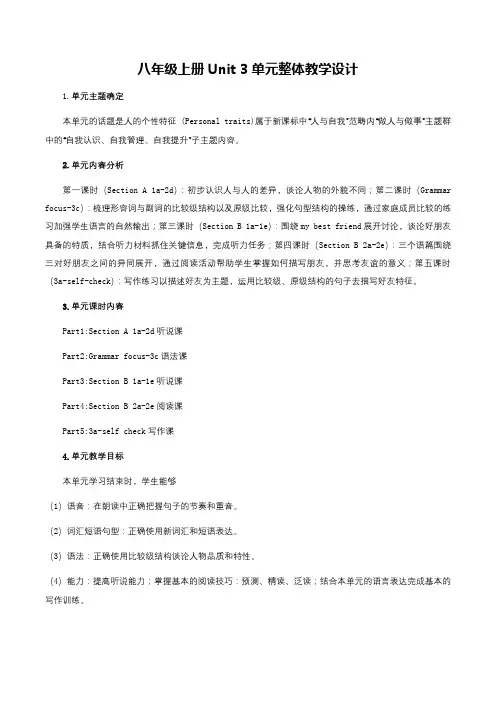
八年级上册Unit 3单元整体教学设计1.单元主题确定本单元的话题是人的个性特征 (Personal traits)属于新课标中“人与自我”范畴内“做人与做事”主题群中的“自我认识、自我管理、自我提升”子主题内容。
2.单元内容分析第一课时(Section A 1a-2d):初步认识人与人的差异,谈论人物的外貌不同;第二课时(Grammar focus-3c):梳理形容词与副词的比较级结构以及原级比较,强化句型结构的操练,通过家庭成员比较的练习加强学生语言的自然输出;第三课时(Section B 1a-1e):围绕my best friend展开讨论,谈论好朋友具备的特质,结合听力材料抓住关键信息,完成听力任务;第四课时(Section B 2a-2e):三个语篇围绕三对好朋友之间的异同展开,通过阅读活动帮助学生掌握如何描写朋友,并思考友谊的意义;第五课时(3a-self-check):写作练习以描述好友为主题,运用比较级、原级结构的句子去描写好友特征。
3.单元课时内容Part1:Section A 1a-2d听说课Part2:Grammar focus-3c语法课Part3:Section B 1a-1e听说课Part4:Section B 2a-2e阅读课Part5:3a-self check写作课4.单元教学目标本单元学习结束时,学生能够(1)语音:在朗读中正确把握句子的节奏和重音。
(2)词汇短语句型:正确使用新词汇和短语表达。
(3)语法:正确使用比较级结构谈论人物品质和特性。
(4)能力:提高听说能力;掌握基本的阅读技巧:预测、精读、泛读;结合本单元的语言表达完成基本的写作训练。
第1课时教学设计一、教学内容:Section A 1a-2d二、课型:听说课三、语篇研读What: 谈论人物的个性特征对比,1a主题图是校园乐队演唱会,台下学生对舞台上表演者的外貌特征进行比较和讨论,1a-1c的听力部分呈现出主要话题和外貌的比较,2a-2b的听力内容是一位记者对主题图中双胞胎姐妹Tina和Tara的采访对话,就各自性格等方面的特点进行了对比,回答记者问题。

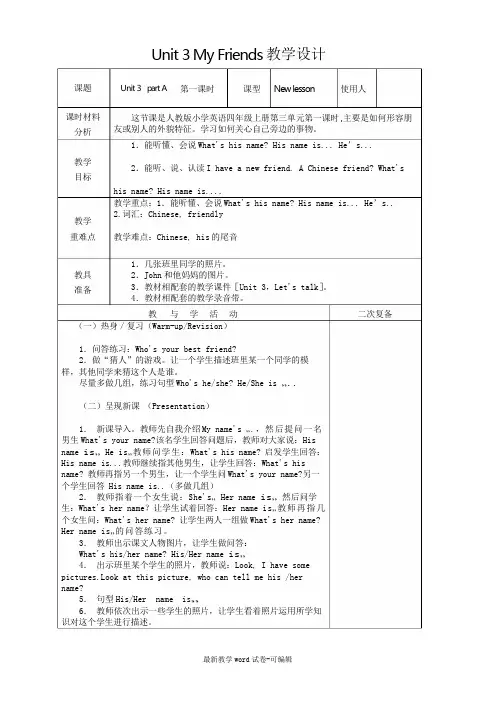
课题课时材料分析教学目标教学重难点教具准备Unit3My Friends教学设计Unit3part A第一课时课型New lesson使用人这节课是人教版小学英语四年级上册第三单元第一课时,主要是如何形容朋友或别人的外貌特征。
学习如何关心自己旁边的事物。
1.能听懂、会说What's his name?His name is...He’s...2.能听、说、认读I have a new friend.A Chinese friend?What'shis name?His name is....教学重点:1.能听懂、会说What's his name?His name is...He’s..2.词汇:Chinese,friendly教学难点:Chinese,his的尾音1.几张班里同学的照片。
2.John和他妈妈的图片。
3.教材相配套的教学课件[Unit3,Let's talk]。
4.教材相配套的教学录音带。
教与学活动(一)热身/复习(Warm-up/Revision)1.问答练习:Who's your best friend?2.做“猜人”的游戏。
让一个学生描述班里某一个同学的模样,其他同学来猜这个人是谁。
尽量多做几组,练习句型Who's he/she?He/She is…..(二)呈现新课(Presentation)1.新课导入。
教师先自我介绍My name's….,然后提问一名男生What's your name?该名学生回答问题后,教师对大家说:Hisname is…He is…教师问学生:What's his name?启发学生回答:His name is...教师继续指其他男生,让学生回答:What's hisname?教师再指另一个男生,让一个学生问What's your name?另一个学生回答His name is..(多做几组)2.教师指着一个女生说:She's…Her name is…然后问学生:What's her name?让学生试着回答:Her name is…教师再指几个女生问:What's her name?让学生两人一组做What's her name?Her name is…的问答练习。
英语教学设计教学课题:人教版高中英语必修一Unit 3 Travel journal Reading: Journey down the Mekong一、设计思路高中英语课程的总目标是使学生在义务教育阶段英语学习基础上,进一步明确英语学习目的,发展自主学习和合作学习的能力;形成有效的英语学习策略,培养学生的综合语言运用能力,使他们在学习过程中,促进心智、情感态度,学习策略,文化意识的发展,形成正确的人生观和价值观,提高人文素养。
该课程标准强调“使语言学习的过程成为学生形成积极地情感态度、主动思维和大胆实践的过程。
”英语教学是一种教与学的双边活动,教学的实质是交际。
从这个意义出发,阅读不应是传统意义上的接受性技能(receptive skill ), 而是一个积极主动的思考理解及获取信息的过程,同时也是作者与阅读者双方参与的言语交际、思想交流的过程。
信息时代的到来需要人们进行广泛而有效的阅读,因而对阅读技巧的培养也提出了更高的要求。
因此,我结合新课标和学生的实际,以任务型教学模式贯穿始终,引导学生自主或者合作完成。
阅读活动由整体入手,由易到难,层层深入。
教学过程中,发挥网络在教学中的优势,图文并茂让学生对主题信息有一个直观的了解。
整个教学活动以教材为载体,以学生为中心,学生参与活动。
二、教学内容分析(一)教材分析1、这节课使用的教材是人教版高中英语必修1,这套教材是在任务型语言教学理念的基础上编写的,它以话题为主线,贴近学生生活,贴近真实的教学行为,它的语言教学理念是强调语言的运用,促进学生自主学习,发展学习的策略,培养创新精神突出实践能力。
2. 第3单元的中心话题是“旅游” ,是一个时尚和热门的话题,不同地区的文化氛围、风土人情和地理特征都能引起学生浓厚的兴趣,激发他们的求知欲。
本节课是这个单元的阅读部分,是王坤写的一篇日记,讲述了她和姐姐想骑山地车旅行,选定了湄公河作为旅游路线,文章具体谈到了他们为这次旅游做的各项准备工作。
unit3课程设计一、课程目标知识目标:1. 学生能掌握Unit 3的核心词汇和基本语法结构,如……(请根据实际教学内容填写);2. 学生能理解并运用本单元的功能句型进行日常交流,如……;3. 学生能理解并复述课文内容,掌握相关话题的背景知识。
技能目标:1. 学生能够通过听力练习,提高对英语语音、语调的辨识能力,提升听力理解水平;2. 学生能够通过口语交流,提高自己的表达能力,增强沟通技巧;3. 学生能够通过阅读和写作练习,提升阅读理解能力和书面表达能力。
情感态度价值观目标:1. 学生能够树立正确的价值观,培养良好的学习习惯,积极投入到英语学习当中;2. 学生能够增强团队协作意识,尊重他人,乐于分享,形成良好的班级氛围;3. 学生能够通过学习英语,了解世界多元文化,拓宽国际视野,增强跨文化交际能力。
课程性质分析:本课程为英语学科的教学内容,针对……年级(请根据实际年级填写)的学生,结合学生特点,注重培养学生的学习兴趣,提高英语综合运用能力。
学生特点分析:该年龄段的学生具有强烈的好奇心、求知欲,善于模仿,但注意力容易分散。
因此,课程设计应注重激发学生兴趣,多样化教学手段,以保持学生的学习积极性。
教学要求:1. 教师应关注学生的个体差异,因材施教,使每个学生都能在原有基础上得到提高;2. 教师应注重培养学生的自主学习能力,引导学生主动探究、积极思考;3. 教师应关注教学过程中的评价与反馈,及时调整教学策略,提高教学效果。
二、教学内容本节课依据课程目标,结合教材内容,组织以下教学重点:1. 教学大纲:- 章节定位:Unit 3;- 教学课时:2课时;- 教学进度:第一课时,学习词汇、语法及课文理解;第二课时,进行口语交流、阅读和写作练习。
2. 教学内容安排:- 词汇:本单元的核心词汇,如……(请根据实际教学内容填写);- 语法:……(请根据实际教学内容填写);- 句型:日常交流中的功能句型,如……;- 课文:理解课文内容,掌握相关话题的背景知识;- 阅读材料:拓展阅读,提高阅读理解能力;- 写作练习:书面表达,锻炼写作技巧。
Unit 3 Campus Life 分课时第3课时教学设计32分钟操练要求学生以小组合作竞赛的形式完成下面的操练,向学生说明竞赛分为三轮,三轮成绩累加,记录团体成绩。
1.第一轮:1)呈现学校建筑照片,引导学生发挥想象描绘图片。
教师适当做句型提示,如:Thisis….There is….Look at…规则:单词,句子描述皆可。
单词描述一次,小组记录1分,句子描述一次,小组记录2分。
(鼓励评价).需要注意的是学生表达不受限。
在学生充分表达之后,教师给出典型句型。
2.第二轮:1)放一遍课文2)知识点回顾学生观看图片,思考,表达。
1.听录音,回忆David的校园生活。
2.明确竞赛规则,团结合作,积极1)充分考虑职教生的基础和接受能力,设计本环节为本节课的高潮部分,通过情境让学生体验语言,让学生模仿和套用。
进行大量操练,在无意识中学习,接受和掌握,是英语教学的一种要求,一种境界,最终实现对语言的交际性运用。
2)小组竞赛在培养抢读,抢译。
抢对一题得1分,和第一轮成绩累加在一起。
3.第三轮:引导学生畅谈校园生活。
1)仿说阶段:呈现一些情景和课文句式,要求学生结合校园生活实际仿说。
句子描述一次,小组记录2分2)自由发挥阶段。
引导学生思考后对校园生活进行补充表达。
学生以小组为单位讨论后发言,难度提升了,所以每参与一次加3分。
4..教师将三轮比赛成绩累加在一起,对学生的参与进行鼓励性评价。
播放职教生活场景照,请学生听一首励志歌曲参与。
学生团结合作和竞争意识的同时,更大程度地提高了学生的课堂参与度。
3)教师的鼓励性评价调动了学生的主观能动性。
6分钟知识技能巩固书信接龙游戏教师说:“歌听完了,同学们是不是更有力量了呢?下面让我们全体同学一起合作做一个书信接龙的游戏吧!每人一句话,完成一封信!像我们的父母或朋友介绍我们的校园生活吧,一起加油,想到了就说!争取不要中断啊Comeon!按照教师提供的书信格式说下去。
从上一环节的说句子过渡到本环节接句子,对学生提出了更高的要求,符合学生的认知规律,并增强了趣味性。
浙江省中等职业学校课本《英语》第一册(浙江省教育厅职成教教研室编)Unit 3 School LifeSection C Reading教学设计The Lesson design on ReadingUnit 3 Section C, BookⅠ学情分析本班学生学习英语具有以下特点:1、学习英语动力不足,只停留在感官认识上——主要表现在喜欢接触新鲜英语材料,如图片,音像资料等,但是落实到学习实处时动力不足;2、只会简单操练,课堂会话欠加强——主要表现在对不同话题只会简单机械模仿,自由会话明显不够,小组讨论有待加强;3、学习目标明确但能力存在障碍——主要表现在希望通过出色的表现来实现被尊重的自我需求,但是学习基础低下、学习方式落后。
具体到本课时,同学们已经掌握谈论最喜欢的课程和最喜欢的校园活动这两个句型并能模仿操练;但对阅读方法掌握不够,影响阅读速度和质量。
教材分析本单元是浙江省中等职业学校英语第一册的第三单元,单元主题是“School Life”。
本课时为Section C的第一课时,仍延续“School Life”这个话题并加以延伸,是一节阅读课。
阅读是组成英语课程资源的基本要素。
Section C主要通过四个小标题:Courses、School Activities 、Friend 、Jobs,勾勒出本单元的话题,引出阅读文章“American high school life”,让学生了解美国学生高中生活。
通过略读、查读、精读和小组讨论等形式,让学生对课文的内容有所了解,并一起讨论中美高中生活的异同之处,同时培养学生的阅读技巧和方法,从而提升他们的阅读能力。
教学目标通过本节课的学习,学生们将会学习到:1、知识目标(1)正确朗读新单词yearly, prom, celebration, babysit, lawn,并掌握skill, include, through, social, education, besides, offer等四会单词。
(2)了解美国高中学生的学校生活。
(3)初步接触感叹句的基本结构。
2. 技能目标(1)运用文章标题、图片等相关资源信息预测文章大意。
(2)用预测、略读、查读等方式把握文章大意和基本结构。
(3)利用提示,谈论中美两国高中学生学校生活的异同。
3. 情感目标(1)了解美国高中学生的校园文化。
(2)尝试用恰当的语言和方式表达自己的思想和感情。
教学重点1.掌握skill, include, through, social, education, besides, offer等四会单词。
2.能运用文章标题、图片等相关资源信息预测文章大意。
教学难点1. 能运用预测、略读、查读等方式把握文章大意和基本结构。
2. 能利用提示,谈论中美两国高中学生学校生活的异同。
教学策略头脑风暴、小组合作学习、任务型学习教学辅助多媒体、黑板、CD教学过程:Step1. Lead-in1. T: In the two parts, we have learned a lot about our school life. Do you know what Chinese school life is like? (Show some pictures about Chinese school life on the PPT)T asks: “What do Chinese high school students do in the school?(Ss give as much as possible about school life, including study, sports, all kinds of activities and so on.)2. Discussion and Brain-stormingAccording to the Ss ’ answer, T asks: “What subjects do you study in theschool?”T: What kinds of activities do you have in the school?(Make the Ss have a Brain-storming .)activitysubjecStep 2 Predicting and ScanningT: Today we will continue to learn something about school life .Please read the title of the passage together,guess what words will be mentioned in the passage.A: Read and tickStudents read the title together. Then think and tick the words which may be mentioned in the passage. Some students stand up to give their ideas.B: ScanningNow please read the passage as quickly as you can. Remember to underline the words and phrases you correctly predicted or missed just now. Then write them down in B.T: Please notice the titles and headings, the first and last paragraphs, the pictures and charts. These can help you master the general idea.Step3. SkimmingOK, let’s see what the students’life is like in American high schools. Please read the passage (paragraph 2-5) quickly and answer these questions.1.Can you list the courses that American high school students have?2.Which kind of activities do the most students like to take part in?3.What is the important thing for many students?4.Do you know what is the first part-time jobs for many high students?Step4. Intensive readingT: Now we have got some information about the passage. Please read it more carefully and finish these tasks.Task1Par1. 1. Arrange the order: high school primary school middle school High school middle school.After school high school.3. High school includes grades ______ through ______.Task2Par2- 5. fill in the form.Task3Par6.a wonderful school life!wonderful the school life is!Step5. Group Discussion1. T: How many parts of American High School life are mentioned in the passage?Ss: Four.T: What are they?Ss: courses, activities, friends and jobs. (the Ss answer and the T writes them down on the Bb)T: The passage is divided into three parts: the beginning, the body and the ending. (write down on the Bb)2.An American high school student’s life is not all the same as ours.Some parts are the same, but some are different. Could you describe which part is the same and which part is different? Please discuss in groups. (Ss work in Groups and T gives the beginning)An American high school student’s life is not all the same as ours. Firstly, they finish their high school education in ____ years. But we finish our high school education in ____ years.Secondly, courses …Thirdly, activities..,Fourthly, part-time job…What’s more, I think we have the same idea about making friends…e the new words and phrase to retell the story.2.Listen and read the passage three times.3.Finish off the Ex in the workbook.板书Unit3 School Life Section CBeginning: (Part 1)Most American high school students live a wonderful school life.coursesBody activities(part2-5) friendsjobsEnding: (Part 3)What a wonderful school life!教学反思本节课是Section C的第一课时,主要要解决“American high school life”的阅读材料,学生通过阅读掌握查读、略读和精读等阅读技巧;通过学习了解了中美高中生活的异同;通过小组讨论、合作学习,提高了学生的会话能力。